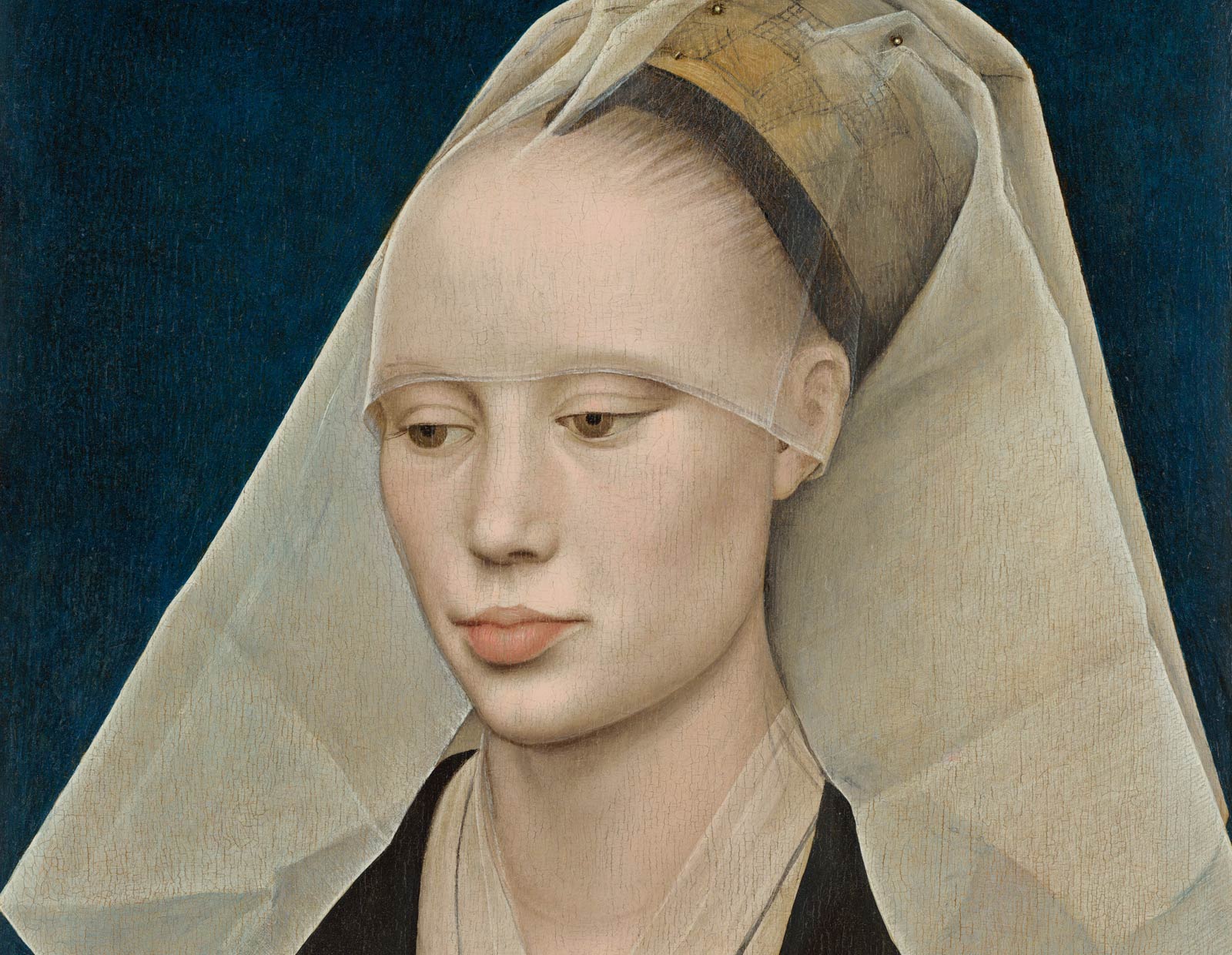Her name is lost to us, but she was likely at the court of Philip the Good, Duke of Burgundy. The court was the mid-15th century’s most magnificent and established tastes for virtuosity and refinement across Europe.
The gold filigree decorating her belt, the folds creasing her transparent veil, her delicate lashes, all seem very real. Yet we sense that this woman is at some remove from the world and from us. Her down-turned eyes and nervously pressed fingers suggest introspective emotion. Triangular forms abstract and flatten her image, giving it a formal elegance that underscores her aristocratic reserve.

Chroniques de Hainaut. Royal Library of Belgium.
A view of the Burgundian court
The miniature on the dedication page of the Chroniques de Hainaut is believed by many to have been painted by Rogier. If so, it would be his only surviving manuscript illustration. Philip the Good stands beneath the canopy. With him, on his left, are the 15-year-old son who would succeed him as duke, Charles the Bold, and probably his older, illegitimate son, Antoine, the Grand Bastard of Burgundy.
Portraits by Rogier van der Weyden and Workshop

Rogier van der Weyden, Portrait of a Lady (X-Ray)
Sharp, interlocking shapes produce a severe balance of form in this portrait. Notice how the fall of the veil over the sitter’s shoulders responds to the V of her neckline, and how her body divides the deep blue-green of the background into framing triangles. The alternation of black and white in her dress, bodice, and veil are relieved only by a red belt (which x-rays show was altered from her original even more slender waist). The shallow planes of her face, painted in a spare, linear manner, are made more abstract by the exaggerated proportions created by then-fashionable plucked brows and hairline. She is defined more by contours than by three-dimensional forms, except in her full, sensual mouth.

Compare the less abstract quality of this portrait painted earlier in Rogier’s career. Some have suggested it represents the artist’s wife. She exhibits none of the aristocratic hauteur seen in the National Gallery picture.
Rogier van der Weyden, Portrait of a Young Lady, c. 1440. Staatliche Museen zu Berlin, Gemäldegalerie
Many of Rogier’s portraits were parts of devotional diptychs, a form he helped popularize. In these hinged two-panel works, the sitter, typically on the right, was depicted in prayerful attitude toward a religious image, usually the Virgin and Child, on the opposite panel. This painting, however, may have been an independent portrait because the woman’s hands are not steepled in prayer.
About the Artist

Rogier van der Weyden, Saint Luke Drawing the Virgin, c. 1435-40. Museum of Fine Arts, Boston.
Luke was the patron saint of painters, and it is possible that Rogier used his own likeness for the saint's face.
Little is known about the life of Rogier van der Weyden. While a few of his paintings can be documented, not a single signed or dated work survives. He was, however, together with Jan van Eyck, the greatest painter working in the Low Countries in the 1400s. His inventiveness and emotional intensity influenced other artists well into the 16th century.
Born in Tournai in 1399 or 1400 to a family of the rising merchant class, he may have received a university education. He began his artistic career uncharacteristically late for the period, entering the workshop of Tournai’s foremost painter, Robert Campin, when he was already 27 years old. In 1432 he was accepted by the guild as an independent master, and by 1435 had moved to Brussels, his wife’s home, where he was appointed official city painter the following year. He lived in Brussels for the rest of his life but during the Jubilee year of 1450 he traveled to Italy and enjoyed an international reputation.
Rogier combined the detailed and meticulous style of his teacher Campin and of Van Eyck, whose work he knew, with an emotional resonance that responded to contemporary religious trends such as the devotio moderna (which stressed meditation and inner life) and the writings of Thomas à Kempis, which emphasized a direct and personal connection with Mary, the saints, and the sufferings of Christ. Rogier’s graceful and expressive figures are set in stark settings and shallow planes; austerity lends them a haunting quality.
Rogier’s most celebrated works are large altarpieces, but he also painted smaller devotional pictures and secular subjects, including civic murals (now lost) for the city of Brussels. Toward the end of his career he created a number of elegant portraits for the Burgundian court, many of which were paired in diptychs with devotional panels.
More Works from the Collection



Explore all Collection Highlights











